
|
|
 |
|
|
|
|
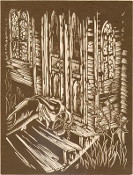
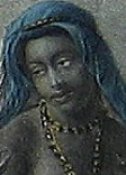
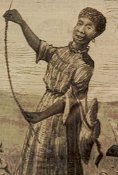
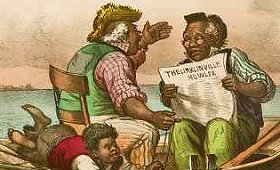 Many lithographs by Currier & Ives cast a romantic shadow over their subjects, from kittens to mischievous children to firemen. That same rosy hue appears in some of their prints illustrating African-Americans, where antebellum plantation life is presented with warm nostalgia, carefully absolved of any unpleasantness. Other, more unusual prints, used the popular medium of lithography to confront issues like abolition. Creating a segregated community of black Americans, Darktown prints showcased a full array of negative stereotypes of former slaves who moved north after the Civil War. Whether implicit or explicit, lithographs from Currier and Ives' now-famous firm offer strong statements on the role of race in nineteenth century American society.
Many lithographs by Currier & Ives cast a romantic shadow over their subjects, from kittens to mischievous children to firemen. That same rosy hue appears in some of their prints illustrating African-Americans, where antebellum plantation life is presented with warm nostalgia, carefully absolved of any unpleasantness. Other, more unusual prints, used the popular medium of lithography to confront issues like abolition. Creating a segregated community of black Americans, Darktown prints showcased a full array of negative stereotypes of former slaves who moved north after the Civil War. Whether implicit or explicit, lithographs from Currier and Ives' now-famous firm offer strong statements on the role of race in nineteenth century American society.
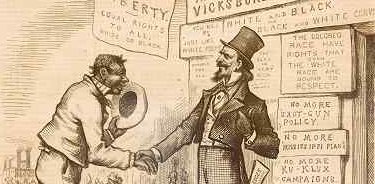 Harper's Weekly was a New York based newspaper in the last half of the nineteenth and early twentieth century. In weekly issues, Harper's presented a mixture of news stories, gossip, poetry, and most notably, wood-engraved illustrations. Especially for matters of popular culture, these illustrations are among the most valuable sources for historians of the everyday. Regarding race, Harper's Weekly prints reveal the place of African-Americans in both popular news and popular opinions of the Victorian period. Political cartoons used the black man as an allegorical figure enmeshed in Reconstruction battles following the Civil War; vignettes of the everyday illustrated his roles in the economy of the new South. Finally, the magazine's "Blackville" series played off the success of other derogatory images, creating a parody of middle-class life in a segregated, black community.
Harper's Weekly was a New York based newspaper in the last half of the nineteenth and early twentieth century. In weekly issues, Harper's presented a mixture of news stories, gossip, poetry, and most notably, wood-engraved illustrations. Especially for matters of popular culture, these illustrations are among the most valuable sources for historians of the everyday. Regarding race, Harper's Weekly prints reveal the place of African-Americans in both popular news and popular opinions of the Victorian period. Political cartoons used the black man as an allegorical figure enmeshed in Reconstruction battles following the Civil War; vignettes of the everyday illustrated his roles in the economy of the new South. Finally, the magazine's "Blackville" series played off the success of other derogatory images, creating a parody of middle-class life in a segregated, black community.
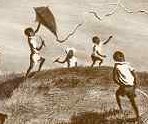 In the fine art prints of the early twentieth century, skin color is visible but increasingly peripheral: artists focus attention on other qualities and actions of their black subjects. Though racist sentiment and actions have not disappeared, the arts foreshadow a rising consciousness of civil rights as they expand the spectrum of black images in American visual culture.
In the fine art prints of the early twentieth century, skin color is visible but increasingly peripheral: artists focus attention on other qualities and actions of their black subjects. Though racist sentiment and actions have not disappeared, the arts foreshadow a rising consciousness of civil rights as they expand the spectrum of black images in American visual culture.
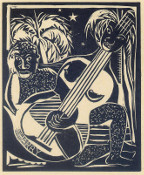 An exciting find seemed to have appeared on the market recently, concerning the estate of an unknown African-American printmaker, Earl M. Washington. Carefully described as the product of a collection of wood blocks from Washington's famous friends and acquaintances, like Eric Gill, Lynd Ward, Rockwell Kent, Hale Woodruff, and others, it is now evident that the "find" was the result of an elaborate scam perpetrated by this printmaker's supposed great-grandson, also named Earl M. Washington. Though their provenance is dubious, they are most interesting in that history. The eagerness with which they were initially accepted speaks to the growing modern interest in the work of early African-American artists and artisans. Though we know now that they are not what they seemed, these prints are still very good "original" copies of some very fine wood block prints, especially those of African-American figures and subjects.
An exciting find seemed to have appeared on the market recently, concerning the estate of an unknown African-American printmaker, Earl M. Washington. Carefully described as the product of a collection of wood blocks from Washington's famous friends and acquaintances, like Eric Gill, Lynd Ward, Rockwell Kent, Hale Woodruff, and others, it is now evident that the "find" was the result of an elaborate scam perpetrated by this printmaker's supposed great-grandson, also named Earl M. Washington. Though their provenance is dubious, they are most interesting in that history. The eagerness with which they were initially accepted speaks to the growing modern interest in the work of early African-American artists and artisans. Though we know now that they are not what they seemed, these prints are still very good "original" copies of some very fine wood block prints, especially those of African-American figures and subjects.
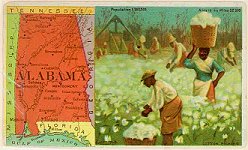
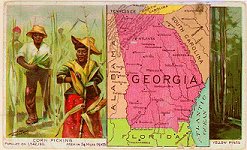
Delightful maps issued about 1890 by the Arbuckle Bros. Coffee Company. This firm was founded by John and Charles Arbuckle of Pittsburgh, PA. They developed a machine to weigh, fill, seal and label coffee in paper packages, which allowed them to become the largest importer and seller of coffee in the world. Their most famous promotional program involved the issuing of several series of small, colorful trading cards, one of which was included in every package of Arbuckle's Coffee. These series included cards with sports, pastimes, historic scenes, and--one of the most popular--maps. The latter cards included not only a map, but also small illustrations "which portrays the peculiarities of the industry, scenery, etc." of the region depicted. These cards, showing Georgia, Alabama, and African-American pastimes, illustrate the vital role that African-American sharecroppers played in Southern agriculture as well as the stereotypes fostered of such laborers.
After a strong start, the magazine found itself struggling to compete with its very similar rival Puck, but revived in the wake of the 1884 Blaine-Cleveland contest when the GOP leadership recognized the power of comic journalism in a political campaign. With GOP aid, Judge boomed during the '80s and '90s, surpassing its rival publication in content and circulation. Bound up in the political and social issues considered by staff cartoonists were the issues of race relations, around which regional politics swirled throughout the postbellum period. Here, those themes are considered from a decidedly Northern perspective, though considerable prejudice is still apparent.
In the early nineteenth century, black face minstrel shows began to appear on the American entertainment landscape. Seen as a distinctly American form of musical, the genre remained steadily popular throughout the century. Characters like "Jim Crow" became standard parts played by white performers, who would use burnt cork to blacken their skin. Modeled after white perceptions of black slaves on Southern plantations, minstrel songs drew unflatteringly on Southern black dialect and vocabulary to construct songs that white audiences of the period found comical. In addition to widespread performances, minstrel songs were popularized through sheet music adorned with heavily decorated lithographed cover images, visual manifestations of the lyrical caricature within.
"Negro Cabin." From A New and Popular Pictorial Description of the United States. New York: Robert Sears, 1848. 7 7/8 x 4 3/4. Wood engraving. Excellent condition. $45
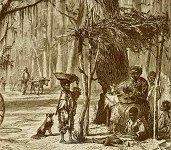
Harry Fenn. "A Road-side Scene Near Charleston." From Picturesque America. New York: D. Appleton & Co., 1873. 5 7/8 x 6 3/8. Wood engraving. Excellent condition.
One of a set of prints from Picturesque America, a book inspired by the prose of William Cullen Bryant. This two volume set and others of its genre were very popular during the mid-nineteenth century, as the impending national Centennial inspired a growing sense of national pride. Through their ample illustrations they provided a glimpse of nineteenth century America -- its towns, rivers, ports, important architecture, and other areas of interest. In this image, one of the issues that threatened that sense of nationalism appears: an African-American family, though no longer enslaved, is still living with the harsh realities of the Southern economy during Reconstruction. $40
"American Sketches: A Negro Congregation at Washington." London: The Illustrated London News, November 18, 1876. Wood engraving. 9 3/8 x 13 3/8. Very good condition. $90
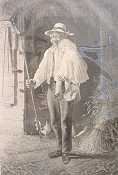
Thomas Waterman Wood. "Uncle Ned and I." New York: C. Klackner, 1882. Engraving by J.A.J. Wilcox. 24 3/4 x 16 3/4. Wide margins. Some old surface abrasions, mostly in the margins; expertly conserved. Otherwise, very good condition and fine appearance.
Noted for his sympathetic images of African-Americans, American painter Thomas Waterman Wood earned the Water Color Society of New York's prize with his painting "Uncle Ned and I." Born in abolitionist New England, Wood came of age as a portrait painter in antebellum Boston, where he studied with Chester Harding. His later travels took him around the country and the world before he settled in Montpelier and New York, focusing on American genre subjects. About one quarter of his paintings focused on African-American subjects, who he portrayed with remarkable sympathy for the period. Though "Uncle Ned" echoes the titles "Uncle" and "Aunt" given to enslaved Africans (and held over in post-bellum years), the subject here appears in much the same garb and stance as Wood's Caucasian farm worker subjects. The sentimental dignity afforded to both man and child here reflects the Victorians' obsession with the virtue of childhood. Rather than presenting an African-American man as a comical or political symbol, Wood portrays him here as a man, in much the same position and light as a Caucasian man of similar age and occupation. $850
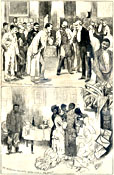
A.B. Shults "New York City. - Contrasts in the Courtesies of New Year's Day." From Frank Leslie's Illustrated Newspaper. New York: Frank Leslie, January 7, 1882. 13 7/8 x 9. Wood engraving.
Frank Leslie was one of the most important publishers of wood engraved prints during the second half of the nineteenth century. His Leslie's Illustrated Newspaper was one of the two largest weekly papers in the United States and he was involved with other publications, including the Historical Register of the Centennial Exposition, a bound volume of text and wood engraved illustrations concerning the Centennial Exhibition held in Philadelphia in 1876. Here, in one of his newspaper's seasonal illustrations, it appears that any man wearing the fashionable Ulster coat is treated best, both by the politicians and by the African-American society ladies. $55
For further information, please contact:

![]()
106 E. Lancaster Avenue, Lower Level
Wayne, PA 19087 USA
610.808.6165
PhilaPrint@PhilaPrintShop.com ![]()
©The Philadelphia Print Shop Last updated July 13, 2021